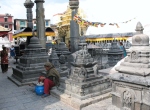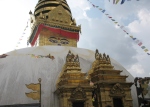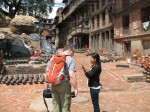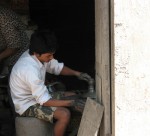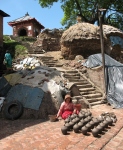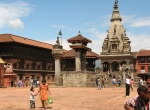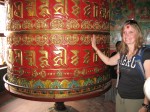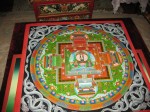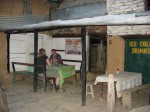I wondered how this could happen. I had done all the right conditioning for a solid year, and brought all the right equipment. Even Emergen-C, which we forgot we had too late.
Figured out that we were having to cover about 14 miles on our first day, and that about five of those could have been covered the day prior after we were dropped in Besishahar. To the guide’s credit, he gave us the choice to stay in Besi the night before or to hike to the trailhead at Bhulbule to arrive at 7:30. Can’t help but use 20/20 hindsight to consider that advance hiking might have saved the trek. The seven hour bus ride from Kathmandu ended up taking nine hours, and was filled with harrowing near misses and unscheduled stops, so we decided to take the accommodation at Besi and just start the next morning.
This aside, the afternoon we had to turn back from the trail, our guide Dilman said we were going back to the next “town” to a “basic” level tea house to stay for the night and build a plan for the next day. We knew we were in trouble when Dilman advised us that no one ever stays at this place.
We had seen this place a few hours earlier. Bhirpustung was more like a farming neighborhood with a couple of neighbors than a bona fide village, and we were fixing to be the village idiots. Regrettably, we did not get the name of the family at the farmhouse, and they attempted dearly to please us. They led Dilman, the two porters, Rebecca, Michelle and me up to our “suite”. The home was clapboard, plaster, mortarless brick, beams, and sheet metal with a couple of incandescent lightbulbs hanging in the one downstairs room and the three very tiny upstairs rooms. The floors were dirt and dung, but they did have a nice porch with benches and a few bottles of cold water approved by the World Health Organization. Out back, there was an attached kitchen and a garden growing mostly cannabis and a few stalks of corn.
We were in one room upstairs near an open window with drapes and a whole company of wasps, mosquitoes, and a female tarantulas that had left a host of bug and male spider carcasses in the beam cracks. I was squeamish and the ladies were terrified. We discussed trying to forge on to the first official stop, but we all agreed that my condition was still quite compromised and we decided to bear with. Michelle originally had her own tiny room, but moved in with us to share and Rebecca and I in turn shared what amounted to a twin sized, elevated board with a very thin pad and a pillow of sketchy hygienic veracity.
An acrid smoke that smelled of burning chemicals and plastic emitted from a fire the family lit to repel the wasps and mosquitos. I believe many of the contents of this fire were banned for use a half century ago.
We sat upstairs in our room, digesting the shock and horror of our immediate surroundings when the lady of the house called us downstairs for dinner. Our dismay was not only for us, but for the life condition our hosts would face after we were gone.
The lady of the house was attractive with a bright, decorated, yellow sari and very cheerful and eager to please. We sat an hour and forty-five minutes while she bounced from task to task, and while I was trying to choke down enough water to stave off further damage to my system.
Rebecca strolled around back to take pictures and found the lady in the kitchen chopping vegetables on the dirt floor. These very vegetables would come into play later that very evening. All of us were the polar opposite of hungry, but the family was going without dinner to serve us — so we ate. Rebecca in particular had a very bad feeling but all insisted that we partake.
She served dal bhat (lentils and rice) and curried vegetables. We did the best we could to finish, and spoke to the man of the house who explained that he has two sons in private school (education in Nepal is supposed to be free, but it’s not really) and that he likes to sit around and drink at night. He seems to be the broker of all business transactions in the immediate area, as we ended up at his home and wound up taking his friend’s jeep to Besishahar the next morning even though Dilman said we were making other arrangements further down the road. This guy seemed to be the local godfather, but his family’s condition made us wonder where the money went.
After dinner we immediately retired up the very steep wooden steps to our suite. It was 8:00 and sure to be amongst the longest nights of our lives. The three of us got into our respective beds, and low conversation murmured downstairs as the night descended into pitch black.
I opened my eyes after drifting off hoping at least a few hours had passed and I guessed it was a bit past midnight. The conversations had stopped and we were truly in total darkness with occasional lightning off in the distance. I illuminated my Casio Pathfinder. It was 9:18. Sigh. Pain radiated through my hips from the pressure of the hard board and cramped conditions of Rebecca and I sharing the bed. Michelle’s plight was certainly not much better, but at least she seemed to be sleeping while we could not.
Sleep was elusive and continued in fits and starts. About 11:00 Rebecca’s stomach began making noises akin to a theremin woo-wooing in a 1950’s horror movie. Fortunately, her Black Diamond head lamp was already on her head so she grabbed the toilet paper darted up in the pitch black, made her way to the steps, and the head lamp malfunctioned. Sometimes it would stay on, but other times it went to strobe and had to have woke up everyone else in the home. To attempt the steps without a light, however, would have been suicidal.
The bathroom was out the back door, through the cannabis garden, down some steep rock steps made lethal slick by a torrential monsoon rain, and was a squatter that you had to scoop water into to finish the job in pitch dark. Rebecca’s food poisoning was in full swing, but being strong she only got up one other time that night in spite of vicious cramps and rumbling. I was not AS sick and got up twice myself. By the way, she is recovering with antibiotics and is doing fine, but the sickness has been awful given the duration and nature of the rides back to Besishahar and Kathmandu. All hail Immodium!
After an eternal night of sleeping in fits and starts, jabbing pain in my back and hips, incessant and torrential monsoon pounding the tin roof, a rat chewing Michelle’s bedpost, and ongoing dehydration, 5:00 a.m. mercifully arrived.
Dilman informed us we would be hiking to the next town down the trail and across the Khola River (Thulo Besi, I believe) to catch the jeep back to Besishahar. It was a fairly quick 45 minutes hike and I performed fairly. It was a village that appeared to be working on a hydro-electric project, and we would have only an hour’s wait for the jeep. We attempted to rest in the shade, but curry cooking invaded our sensitive systems and it was all we could do to stay well.
The Jeep arrived and the porters packed in our duffels the Godfather from the previous town in tow. I hoisted my pack preparing to board and my feet went out from under me on a small but steep bank of rocks. I landed on a sharp rock directly on the front of my left shin, wounding to the bone and gouging out a large chunk. Everyone rushed to my side and Rebecca and Michelle piled out of the car to my aid. We applied antibiotic ointment and gauze, but it didn’t stop bleeding for a few days. Like everything else, all is well now — it is healing over.
The trail we drove was across the river from our trekking trail, so we could see our waypoints from the previous day by looking across. The road seemed one monsoon rain away from becoming impassable, and there were hundreds of foot drops on the cliffside of the road.
We checked out of the circuit at Bhulbule and retraced our steps back to Besishahar in the Jeep. This portion is mixed foot and vehicle traffic. Two hours after having left Thulo Besi, we arrived Besishahar at 10:00 am in the Jeep and rested and showered at the guest house before taking a private car back to Kathmandu at 2:00 p.m.
Pictures when we get back.








